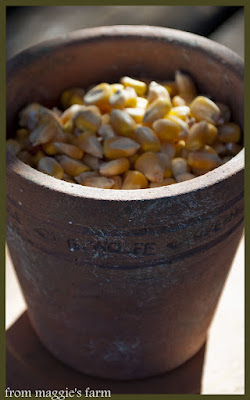notes from maggie's farm
making cheese: from goat to plate
Meet Sheba. You'll need one of these. Or maybe just access to one of these. We have one of these.
This is goat crack. If you have one of those, you'll need some of this.
I have her eating out of my hand. Because goats will do just about anything for goat crack.
Meet the cowboy. It really makes things a lot easier if you have one of these...
...because your cowboy might milk your goat while you snap shots. Otherwise, it's you, the goat, and a tripod. You'll need another hand, too.
The holy grail. This is liquid gold. This is cheese. Or it will be tomorrow.
Strain milk through fine meshed cheesecloth, called butter muslin, to remove any impurities.
a gallon of milk makes a pound of cheese.
You'll need four quarts of goat milk. If your goat has been less than prolifically forthcoming (you'll want to use milk that is no less fresh than 5 days old), freeze milk, strained, in sterilized quart jars, leaving 3 inches of headspace, to avoid breakage. If you're using raw milk that you've purchased, you'll get the best results from milk that's 3-5 days old.
In an enamel coated cast iron, copper, or stainless steel stockpot, slowly heat milk, stirring often. Milk scalds easily. Scalded milk does not tasty cheese make--so stick around.
Heat milk at a low temperature. Depending upon your heat source, this should take around thirty minutes...
...until milk reaches a temperature of 175 degrees.
Reduce heat, and hold at temperature, stirring occasionally, for ten minutes.
The magic elixir-- two to four ounces of vinegar. White vinegar is customary and will yield the best whey separation, thus a firmer cheese. Cider vinegar yields a softer cheese, say, like the texture of a silky cottage cheese.
Remove from heat and slowly pour in the vinegar, stirring gently through, once or twice.
Voila! La separation! ...of the curds from the whey. Notice the clear liquid. That is your milk making itself into cheese, my cheesemaking friend.
Allow milk to sit, covered, for 10 minutes, stirring, gently, once, 5 minutes in. If milk resists separation, don't panic. Add that additional 2 ounces of vinegar. Milk is unique and Mother Nature is a tricky chick. Gotta roll with the cheesemaking punches, sometimes. Strain through butter muslin, reserving whey.
Meet Molly. Molly would like to thank you for reserving the whey for her, and suggests you share some with your animals, too. (there are other great ways to utilize whey, but Molly says ssssshhhhhhh.)
Gather corners of cheesecloth, tie together. Hang to drain for six hours, or overnight.
Scrape the cheesecloth surrounding the ball of curds occasionally to 'clear the pores' of the butter muslin. Midway through draining, turn the ball of cheese in the muslin to facilitate drainage.
You're almost there! About 2t to 1T kosher salt should be sufficient to salt your batch, but this is a matter of individual taste, so do just that--taste! You probably won't mind. You'll be proud as punch that you're seasoning your very own CHEESE. Occasionally, we add herbs, like this herbes de provence mixture. Go ahead--take the plunge. Spicy is good, too! Live life dangerously.
The Masterpiece!
Yes, this still makes us a little emotional. Just look at what you've created. Amazing.

Treat yourself right, you fabulous cheesemaker, you. Be the first one to dig in. You deserve it.
You're such an artist.
See? I told you you were a cheesemaker.























I love your blog, recepies and pictures.
ReplyDeleteThank you so much--you have made my day!
ReplyDeleteI'm so excited to make this. I buy my goat milk on Saturday's and I'm going to make a tiny batch of this (since I only buy a litre's worth at a time). Wish me luck!
ReplyDeleteSuch a fantastic post. Loved this - no wonder it got picked up!
ReplyDeleteThank you my friend! You're a joy.
ReplyDeleteGosh, that is a masterpiece! I am wishing I was there to taste some. I love goats milks cheese, and up here a tiny tiny piece is sooooo expensive...but so worth it. I loved all the pictures you took documenting the process. It is cool to see how it is actually made..
ReplyDeleteHi Winnie,
DeleteA few of my local blogging friends got together over the weekend and I taught them to make a simple cow's milk ricotta. Can't help thinking you would have been a great addition to the mix. Thank you for your kind words.
That is one happy goat and I'm sure some divine tasting cheese. It looks fabulous!
ReplyDelete